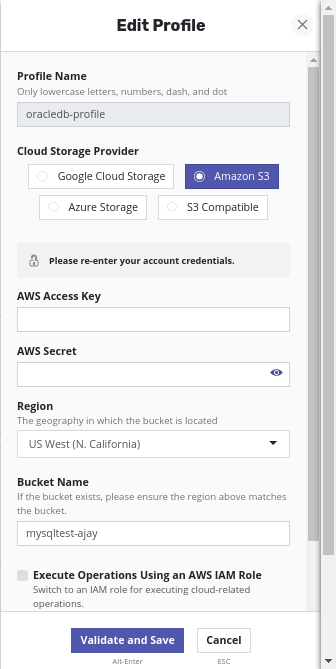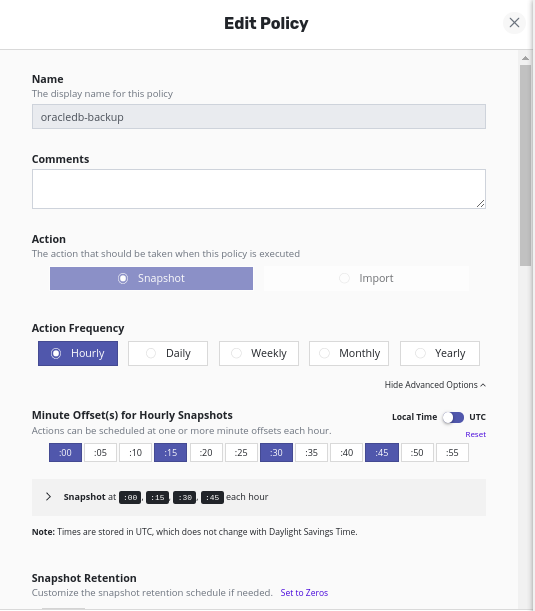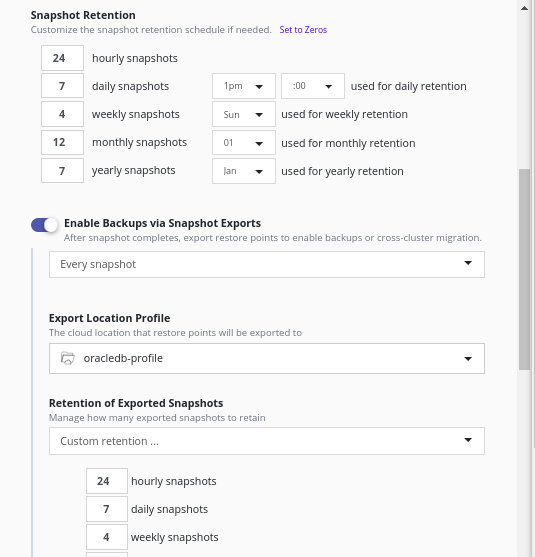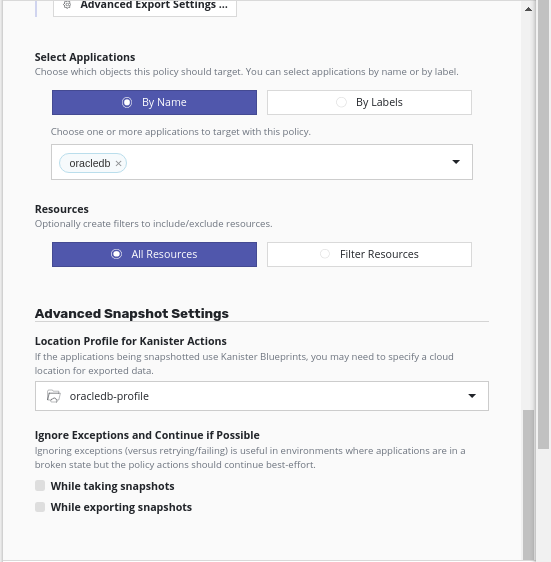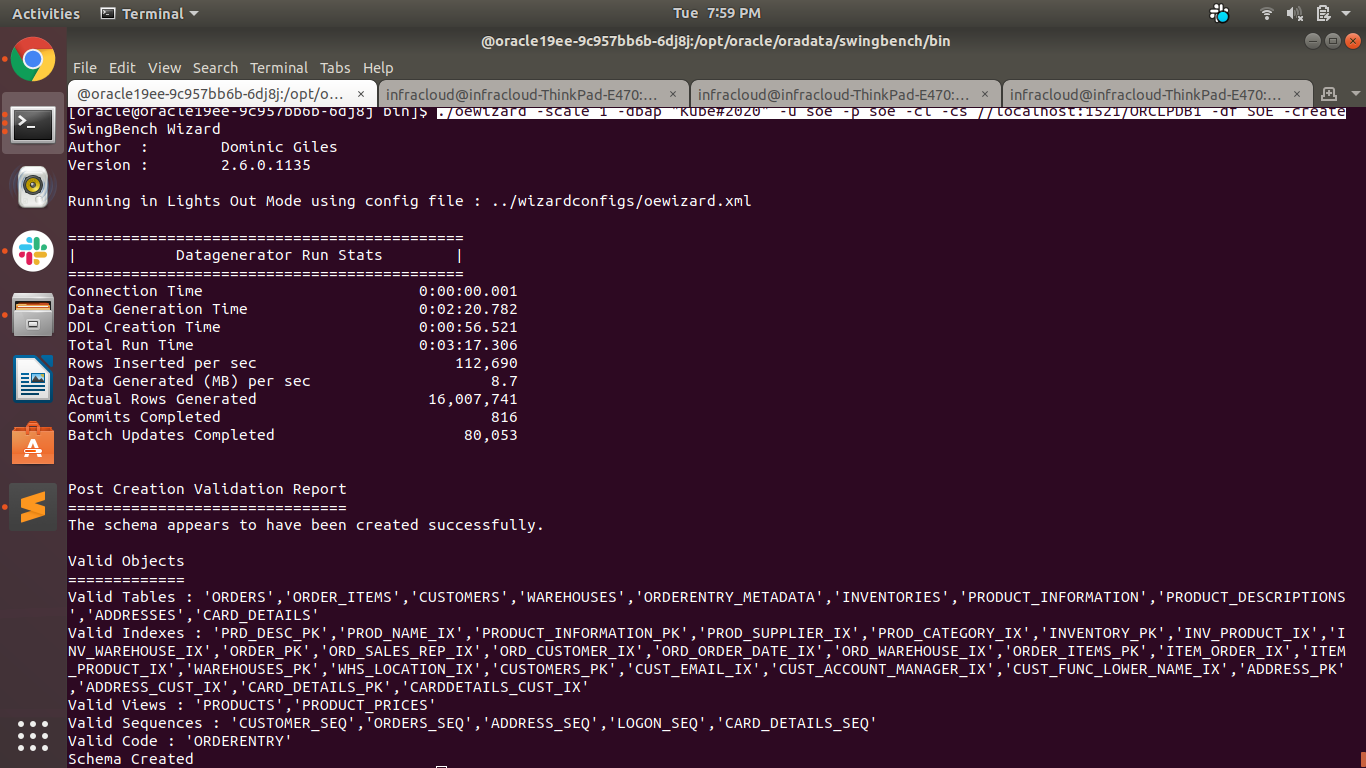ORACLE Database is a multi-model database management system produced and marketed by Oracle Corporation. It is a database commonly used for running online transaction processing, data warehousing and mixed database workloads.
In Application consistent backup, Application is notified that the backup is being taken and application transactions/writes are quiesced for a short duration.
In the case of Oracle database, a consistent backup would be done when:
- Current redo is archived, triggering a checkpoint which would write dirty buffer into the files.
- The database is put in backup mode (11g) or using storage snapshot optimization in 12c and later. This will freeze the I/O while the snapshot is taken.
- Third-party snapshot is taken.
- End of backup mode, not required for 12c and later.
- Switch of the log file and optionally, backup of Control file to a backup file is taken.
Referncers: How to prepare the Oracle database for Snapshot Technologies and ensure a consistent recovery [221779.1] Supported Backup, Restore and Recovery Operations using Third-Party Snapshot Technologies [604683.1]
Block Corruption (particularly lost write) can not be fixed by Snapshot based recovery. It requires RMAN or Dataguard for full protection. https://www.oracle.com/technetwork/database/availability/maa-datacorruption-bestpractices-396464.pdf
This Oracle database deployment on Kubernetes cluster with persistent storage and then perform the backup and restore with Kasten.
To install the Oracle database using deployment file with differnt available 12c, 18c and 19c please refer oracle12c, oracle18ee and oracle19ee directory respectively.
Make sure the Kasten(K10) application is installed in your cluster, if not please install it, refer doc
Once you access the K10 dashboard, create a K10 profile.
- Go to Setting > Location > Create Location Profile
- Provide details required, validate and save.
Now create a K10 policy for your application
- Go to Policies
- Create policy and give some name
- Select action type as snapshot
- Provide Action frequency
- Select the available application
- Select Location Profile for Kanister Actions
- Create Policy
Create Blueprint in the same namespace as the Kanister controller. This blueprint is having 3 actions which are performed while backup and restore.
backupPrehook: This action will be executed before the actual snapshot backup, create a restore.sql script with recovery time and sql statement to recover from the database first in host persistance location and then archive the current logs.backupPosthook: This action will be executed after the snapshot backup is done and archive the current logs.restore: After restore from k10 dashboard and once pod is in ready state this action will be executed and run the restore.sql script to make sure that recovery is done properly.
$ kubectl create -f blueprint.yaml -n kasten-ioAnnotate the Oracle Database deployment with newly created blueprint.
$ kubectl -n {NAMESPACE} annotate deployment.apps/{DEPLOYMENT_NAME} kanister.kasten.io/blueprint={BLUEPRINT_NAME}
Once Oracle is running, you can populate it with some data. Let's create schema and generate some load To generate data in Oracle database for simulating load, we are using Swingbench. Swingbench is equipped with a utility like oewizard which loads data. You can use SwingBench GUI from outside the pod to run the load but may lead to increase some responce time.
$ cd /opt/oracle/oradata/swingbench/bin/
$ ./oewizrdYou can copy the swingbench to your running pod and run there for faster operation.
#Download and copy SwingBench zip file to pod persistant volume.
$ kubectl -n NAMESPACE cp swingbenchlatest.zip {POD_NAME}:/opt/oracle/oradata/
$ kubectl -n oracle19ee exec -it pod/{POD_NAME} -- bash
#Set Java path
$ export PATH=$ORACLE_HOME/jdk/bin:$PATH
#Unzip the downloaded file
$ cd /opt/oracle/oradata/
$ unzip swingbenchlatest.zip
$ cd swingbench/bin/
# Create a schema using oewizard
$ ./oewizard -scale 1 -dbap {DB_PASSWD} -u {username} -p {password} -cl -cs //{ORACLE_DB_CONNECTION_STRING} -df '/opt/oracle/oradata/ORCL/{PDB_NAME}/{TABLESPACE_NAME}.dbf' -create
$ ./oewizard -scale 1 -dbap "Kube#2020" -u soe -p soe -cl -cs //localhost:1521/ORCL -df '/opt/oracle/oradata/ORCL/ORCLPDB1/soe.dbf' -create# concurrent number of users
$ USERS=30
# for five minutes
$ RUNTIME="00:05:00"
$ ./charbench -c ../configs/SOE_Server_Side_V2.xml -cs //localhost:1521/ORCL -dt thin -u soe -p soe -uc $USERS -v users,tps,tpm,dml,errs,resp -mr -min 0 -max 100 -ld 1000 -rt $RUNTIME
# Note you can change the values as per your requirement.You can use Swingbench GUI app to generate load from outside the pod as well.
$ cd /opt/oracle/oradata/swingbench/bin/
$ ./swingbenchYou can now take a backup of the Oracle data using an K10 policies for this application. Go to the K10 dashboard and run the policy. Please note a time while running the policy to make sure the db will restored at the same point. This will start the backup process and you can check the logs of currently running pod to see the prebackup and postbackup actions are performed.
# To check the deployment pod logs
$ kubectl -n {NAMESPACE} logs {POD} -fConfirm the backup action policy ran completly in K10 dashboard.
To restore the missing data, you should use the snapshot that you created before. Let's say someone accidentally deleted some data and want to restore data to last backup point.
Go to K10 dashboard, select application restore point from which you want to restore and confirm restore. This will start the restore process and create a new pod with the restrore point snapshot.
Confirm the restore is done completly
# Check If Pod is in ready state.
$ kubectl -n {NAMESPACE} get pods
# Once Pod is ready, connect to the DB and verify the table ORDERS last record and it should equivalent to start time.
$ kubectl -n {NAMESPACE} exec -it <POD> -- bash
$ select SYS_EXTRACT_UTC(max(order_date)) from soe.orders;If you run into any issues with the above commands, you can check the logs of the controller using:
$ kubectl --namespace kasten-io logs <KANISTER_SERVICE_POD_NAME>We can export the AWR report from the database and analyze the performance impact while backup.
$ kubectl -n {NAMESPACE} exec -it {POD_NAME} -- bash
$ sqlplus / as sqlplus
$ @?/rdbms/admin/awrrpt.sql
# provide the deatils like tyep, begin and end snapshot id, file name, it will create a AWR report, copy this file to local and analyze the report fot performace impact.| # | Database Version | CPU / SGA | Users | Avg TPS | Total Tx / 5 min | Snapshot Size | Snapshot Time | Notes |
|---|---|---|---|---|---|---|---|---|
| 1 | 12.2.0.1 | 4C / 5G | 30 | 1000 | 300031 | 40G | 00:02:33 | |
| 2 | 12.2.0.1 | 4C / 5G | 200 | 1075 | 322516 | 40G | 00:04:30 |
To uninstall/delete the oracle deployment:
Please refer installtion page for the deletion of deployment.
Remove Blueprint
$ kubectl delete blueprints oracle-blueprint -n kasten-ioBelow is the database performance charts showing number of commits, database time and redo generated during the test. As you can see in the below chart, we ran a test at 7:52, Database time has a spike but there is not much impact on the number of transactions processed by the database. End user response time was intact. The spike is mainly due to increased time taken the log file parallel write event for the short duration when the snapshot was taken.
